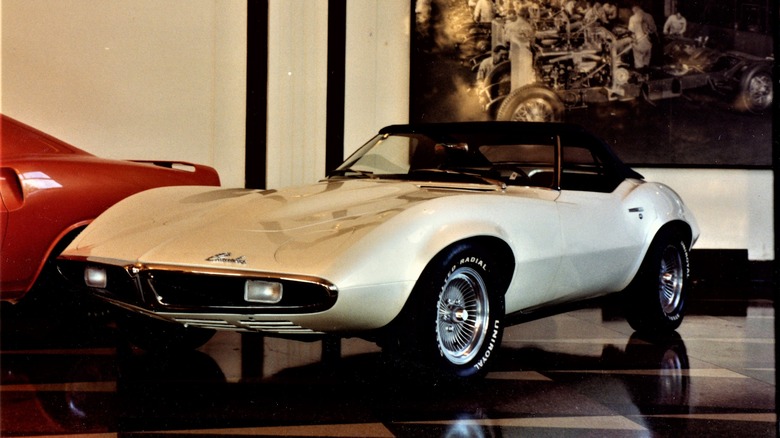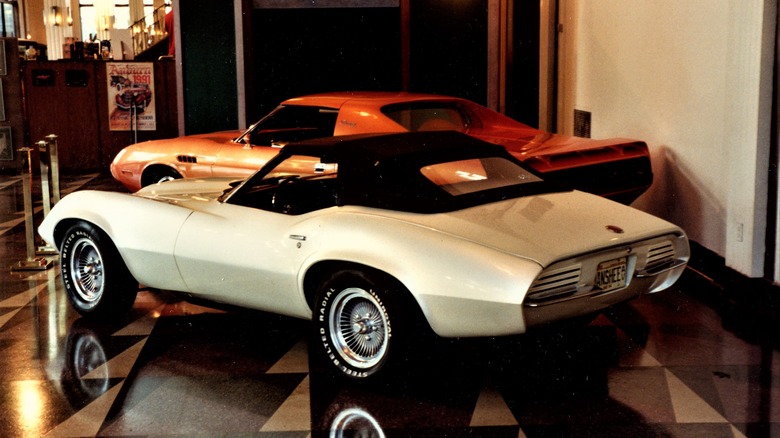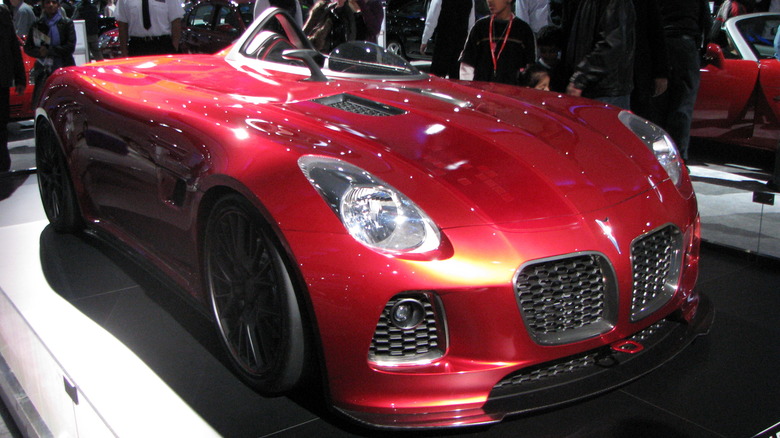5 Pontiac Concepts And Prototypes We Wish It Would Have Built
Even if you don't hear the name much today, Pontiac was once a trendy car brand under General Motors, and it was known for making fast and cool cars. Pontiac made some of the most loved cars from the 1950s to the 2000s, like the Bonneville, Trans Am, and GTO. But in 2010, General Motors had some money problems and had to make tough choices — one such choice being shutting down Pontiac.
When Pontiac was still alive and well, it didn't just make cars that you could buy and drive. They also had lots of ideas for new cars in the form of concepts and prototypes. But making a new car is hard and costs a lot of money, so not every cool idea could be turned into a real car. Sometimes the idea was too expensive. Other times, they weren't sure if enough people would buy it or the car didn't fit with the other cars Pontiac was selling. Problems like these meant many of these cool concepts stayed as just ideas.
These concept cars are interesting because they show us what could have been, and even though these cars were never made, they remind fans worldwide of how creative and daring Pontiac was. In any case, it's just fun to think about what it would have been like if some of these concept cars had been made — so here are five that we wish were built.
[Featured image by Alden Jewell via Wikimedia Commons | Cropped and scaled | CC BY 2.0]
Pontiac Piranha
In a nutshell, the Pontiac Piranha was a supercharged coupe concept with coach doors. Unlike its earlier version, the 1998 Sunfire Piranha, this one was built to appeal to people who love adventure and the outdoors. It looked a bit like a mix between a buggy and a truck, but had the engine of a powerful sports car. At first glance, this car seems to be all about having fun — coach doors for easy access, a convertible fabric roof for sun-soaked drives, and a modular interior that could transform from a cabin to a beachfront setup with its foldable and removable seats.
But don't let the looks fool you. Under the hood was a supercharged GM 2.2-liter Ecotec engine with 212 horsepower, managed by a 5-speed automatic transmission with paddle shift controls that would have made you feel like a race car driver. Besides the specs, the Piranha also embraced personalization — its interior was a marvel of customization, with zip-off fabric door panels and a cargo area designed to be flexible, including a removable tub that could double as a cooler.
Unfortunately, even with all these awesome features, the Piranha never went into production for reasons unknown, but the fact that GM was having financial trouble at the time might have had something to do with it. It's a shame because it could have been a car that stood out for being fun and useful at the same time.
Pontiac Banshee
The Pontiac Banshee is another concept that many car fans generally wish had been made. Back in the 1960s, Pontiac made fast and stylish cars that people loved, but it also faced competition on the sports car front from the likes of Mustang and others. During this time, the company came up with the Banshee, a new type of sports car that could have changed the game altogether, and it was the brainchild of John Z. DeLorean, the man behind the famous DeLorean from "Back to the Future."
There's little doubt that the Banshee looked amazing. It was sleek and light, with a body made of fiberglass, which wasn't common back then. Another reason many car fans had their eyes on the Banshee was that it wasn't just about raw power like other muscle cars. Instead, it was about being quick, light, and fun to drive. It was also designed as a sports car that wasn't too expensive. A six-cylinder engine powered the Banshee, but Pontiac considered adding a stronger V8 engine later. This mix of good looks, decent power, and a not-so-high price tag could have made it a hit.
But, alas, the Banshee never got its chance to shine because GM decided not to make it since they were worried it would compete with their other cars like the Corvette. Even though the Banshee was never made, it's still remembered as a cool car that could have been something special.
[Featured image by Alden Jewell via Wikimedia Commons | Cropped and scaled | CC BY 2.0]
Pontiac Pursuit
The Pursuit is a forgotten Pontiac concept car that still looks futuristic today. With a 2.0-liter turbocharged four-cylinder engine delivering 200 horsepower to the front wheels, it promised fun driving. Speed and performance on the Pursuit were attractive, but what made the car unique was that, even in the 1980s, the car was full of new ideas that are only common today.
Its sleek, futuristic look made it stand out, for sure, but the cool stuff was inside and under the hood. For steering, it used an electronic four-wheel steering and a steer-by-wire system. Inside the car, there was a digital display instead of old-school meters and knobs, which let drivers see all sorts of info like maps and music options right on the dashboard. The Pursuit also imagined other tech like GPS navigation and electronic controls on the steering wheel. These are things we use all the time now, but back when this car was designed, they were just cool ideas.
Pontiac obviously had big dreams with this car, but it was too advanced for its time. Pontiac might've even decided perhaps the market was not yet ready for such avant-garde ideas. Even though we never saw it on the road, the Pursuit will be remembered for its innovative design and ideas. It's a reminder of how creative carmakers can be, and how some of those wild ideas eventually become a part of our everyday lives.
Pontiac Solstice SD-290
The Pontiac Solstice SD-290 concept car was a cool idea from 2007 that mixed old-school racing style with new tech — it was special because it was designed to be light and fast. It was designed to be so light, in fact, that they took out things like the windshield, passenger seat, and back seat. It was painted bright red and looked ready to race with its special windscreen for the driver and a cover where the passenger seat would be.
Performance-wise, the SD-290 was no slouch. Powered by a 2.0L Ecotec direct-injected and turbocharged engine, it had a 290 horsepower output. This powertrain, coupled with a five-speed manual transmission, promised a thrilling driving experience. We were also supposed to get some very fancy tech with this car, like a Solo Performance cat-back exhaust system, KW Automotive coil-over suspension package, and three-piston aluminum calipers with 13-inch rotors from Stainless Steel Brake Company. It also had a racing seat with a four-point safety harness and a removable racing-style steering wheel.
But, even though it was a pretty good statement for sports cars, the Pontiac disappeared after its showing at SEMA and a few events afterward. There's no official reason from Pontiac, but it's assumed that the cost of making this car and its demand wouldn't match. It's sad it was never made, but it's still interesting to think about what it would have been like to drive.
[Featured image by Michael Gil via Wikimedia Commons | Cropped and scaled | CC BY 2.0 DEED]
Pontiac Stinger
In the late '80s, the Pontiac Stinger showed off a fun and new way to think about cars. Like the Piranha, this car was also designed to be perfect for younger people who love spending time outdoors. It looked different from the cars that come to mind when we hear "concept cars" because it was inspired by dune buggies, with an open top and a bright neon green look.
The Stinger was a response to market research on future trends done by Pontiac, which concluded that buyers under the age of 35 wanted something very similar to what the Stinger was — a fun car that could drive and handle both work and play. So, GM's Chuck Jordan and his team went to work. The resulting Stinger had prophetic features, like the carbon-fiber body, removable glass panels, and an interior decked with gadgets for the great outdoors. It also had a 3.0-liter, 170-horsepower engine and an active pneumatic suspension system, which promised performance that could keep pace with its looks.
The Stinger's interior was pretty neat, too, from integrated tool kits and portable vacuums to garden hoses and picnic benches that unfolded from the back. The seats were made from wetsuit material, and the car also came with various storage solutions for outdoor gear. Keeping with the theme of "concepts and prototypes we wish were built," the Stinger never made it to production. But, it was a glimpse into what SUVs and adventure vehicles could become.


